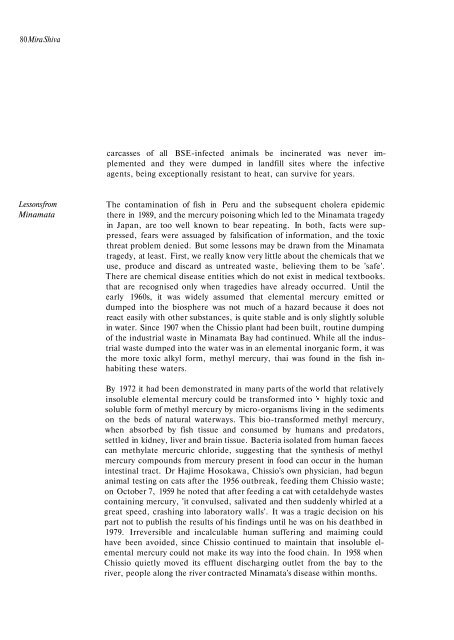Environmental Degradation and Subversion of Health - Dag ...
Environmental Degradation and Subversion of Health - Dag ...
Environmental Degradation and Subversion of Health - Dag ...
Create successful ePaper yourself
Turn your PDF publications into a flip-book with our unique Google optimized e-Paper software.
80 Mira Shiva<br />
Lessons from<br />
Minamata<br />
carcasses <strong>of</strong> all BSE-infected animals be incinerated was never implemented<br />
<strong>and</strong> they were dumped in l<strong>and</strong>fill sites where the infective<br />
agents, being exceptionally resistant to heat, can survive for years.<br />
The contamination <strong>of</strong> fish in Peru <strong>and</strong> the subsequent cholera epidemic<br />
there in 1989, <strong>and</strong> the mercury poisoning which led to the Minamata tragedy<br />
in Japan, are too well known to bear repeating. In both, facts were suppressed,<br />
fears were assuaged by falsification <strong>of</strong> information, <strong>and</strong> the toxic<br />
threat problem denied. But some lessons may be drawn from the Minamata<br />
tragedy, at least. First, we really know very little about the chemicals that we<br />
use, produce <strong>and</strong> discard as untreated waste, believing them to be 'safe'.<br />
There are chemical disease entities which do not exist in medical textbooks.<br />
that are recognised only when tragedies have already occurred. Until the<br />
early 1960s, it was widely assumed that elemental mercury emitted or<br />
dumped into the biosphere was not much <strong>of</strong> a hazard because it does not<br />
react easily with other substances, is quite stable <strong>and</strong> is only slightly soluble<br />
in water. Since 1907 when the Chissio plant had been built, routine dumping<br />
<strong>of</strong> the industrial waste in Minamata Bay had continued. While all the industrial<br />
waste dumped into the water was in an elemental inorganic form, it was<br />
the more toxic alkyl form, methyl mercury, thai was found in the fish inhabiting<br />
these waters.<br />
By 1972 it had been demonstrated in many parts <strong>of</strong> the world that relatively<br />
insoluble elemental mercury could be transformed into '• highly toxic <strong>and</strong><br />
soluble form <strong>of</strong> methyl mercury by micro-organisms living in the sediments<br />
on the beds <strong>of</strong> natural waterways. This bio-transformed methyl mercury,<br />
when absorbed by fish tissue <strong>and</strong> consumed by humans <strong>and</strong> predators,<br />
settled in kidney, liver <strong>and</strong> brain tissue. Bacteria isolated from human faeces<br />
can methylate mercuric chloride, suggesting that the synthesis <strong>of</strong> methyl<br />
mercury compounds from mercury present in food can occur in the human<br />
intestinal tract. Dr Hajime Hosokawa, Chissio's own physician, had begun<br />
animal testing on cats after the 1956 outbreak, feeding them Chissio waste;<br />
on October 7, 1959 he noted that after feeding a cat with cetaldehyde wastes<br />
containing mercury, 'it convulsed, salivated <strong>and</strong> then suddenly whirled at a<br />
great speed, crashing into laboratory walls'. It was a tragic decision on his<br />
part not to publish the results <strong>of</strong> his findings until he was on his deathbed in<br />
1979. Irreversible <strong>and</strong> incalculable human suffering <strong>and</strong> maiming could<br />
have been avoided, since Chissio continued to maintain that insoluble elemental<br />
mercury could not make its way into the food chain. In 1958 when<br />
Chissio quietly moved its effluent discharging outlet from the bay to the<br />
river, people along the river contracted Minamata's disease within months.
















